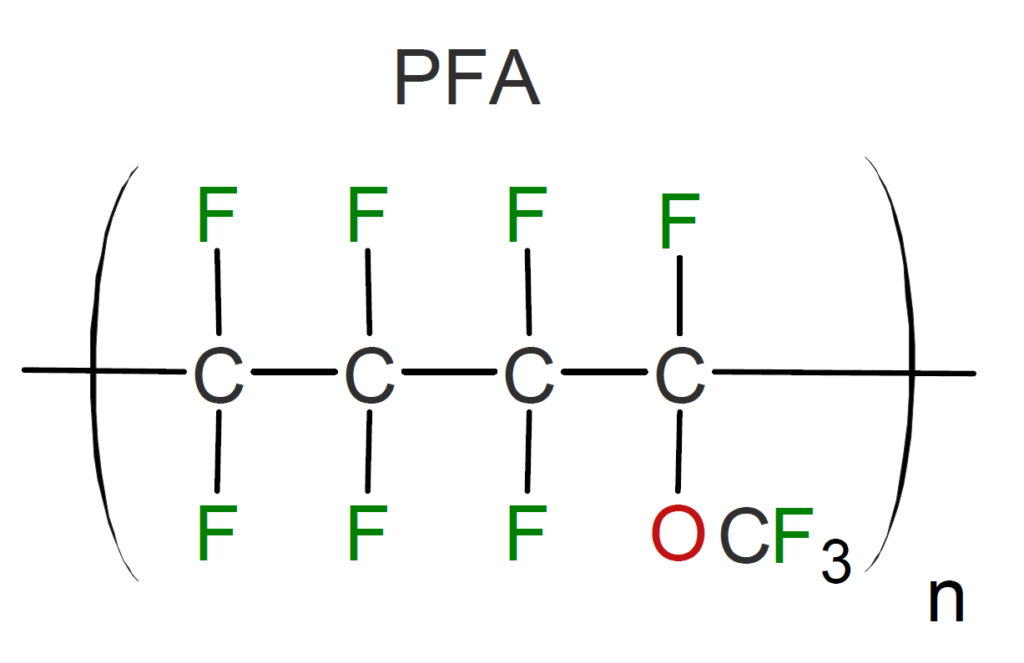What are the “Forever Chemicals”?
PFAs stand for Per- and Polyfluoroalkyl Substances, which are a group of man-made chemicals that have been used in a wide range of industrial and consumer applications for several decades. They were first introduced in the 1940s and have been used in a wide range of industrial and consumer applications since then. Initially developed for products such as non-stick cookware, waterproof clothing, and stain-resistant fabrics because of their unique properties of being resistant to heat, water, and oil. Since then, PFAs have been incorporated into thousands of products, including food packaging and electronic devices, leading to daily exposure, which may have devastating consequences.

PFAs are typically referred to as a double-edged sword. On one side, they are excellent materials for cookware, safety, and lab use because of their persistent properties. On the other side, their persistent means accumulation in the body which can have detrimental effects on our health. Some examples are that PFA is linked with decreased immune function, liver toxicity, and can increase the risk of cancer. These concerns warrant the increasing awareness of PFA’s danger to the environment and government interventions for limiting exposure.
PFAs and Health
The “forever chemicals” as you can guess, are chemicals that are very resistant to natural decomposition. PFAs are resistant to decomposition because of their unique chemical properties. They are composed of long chains of carbon and fluorine atoms, which make them very stable and resistant to breaking down in the environment. The carbon-fluorine bonds in PFAs are among the strongest chemical bonds found in nature.
The resilient nature of these chemicals makes it hard for our bodies to remove them, thus they accumulate in our organs and cause damage.
PFAs are linked to a range of health problems. The scientific community has been studying the health effects of PFAs for several years, and evidence suggests that exposure to these chemicals can have harmful effects on human health.
Some studies have linked PFAs to an increased risk of certain types of cancer, including kidney and testicular cancer. Exposure to PFAs has been linked to effects on the immune system, including decreased antibody response to vaccines, and developmental effects on fetuses and infants, including low birth weight and delayed development. PFAs may also interfere with hormones, which can have effects on reproductive and metabolic health.
Several studies have linked increased PFA exposure to liver damage, including a study published in the journal Environmental Health Perspectives in 2017 found that exposure to PFAs was associated with liver injury in a human population. The study found that individuals with higher levels of PFAs in their blood had increased levels of liver enzymes, which can show liver injury. Other studies have showed that increased exposure to PFAs leads to liver damage in rodent/zebrafish models.
How can you Limit Exposure to PFAs?
There are several ways to limit your exposure to PFAs. This list is not exhaustive nor erases your exposure to the forever chemicals, and perhaps the best way to limit PFAs exposure is to push for policy reform in your region. Currently, the United States Environmental Protection Agency (EPA) has established a health advisory level of 70 parts per trillion (ppt) for PFOA and PFOS (two types of PFAs) in drinking water. Several states have established their own regulations, including California and New Jersey, which have set maximum contaminant levels for PFAs in drinking water. These increasingly stringent regulations help protect citizens from the devastating effects of PFAs, but there is more work to be done. While you are pushing for policy reform, here are some tips for reducing your exposure to PFAs.
While it may seem obvious, steering clear from items that contain PFAs is the best way to start. Some of these items include non-stick cookware, waterproof clothing, stain-resistant fabrics, and food packaging.
- Stainless steel or cast iron cookware can be used instead of non-stick cookware
Another tip is to avoid drinking water contaminated with PFAs. While government regulations have become increasingly more stringent, it is beneficial to get a reverse osmosis water system.
- Reverse osmosis is an effective method for removing many contaminants, including PFAs, from drinking water. Reverse osmosis works by forcing water through a semipermeable membrane, which has a pore size of around 0.0001 microns, that filters out impurities, including PFAs, as the water passes through.
- However, it is important to note that not all reverse osmosis systems are created equal, and some may be more effective than others at removing PFAs. Some types of PFAs may be more difficult to remove than others, and the effectiveness of reverse osmosis may depend on the specific type of PFAs present in the water.
The last tip for avoiding excess exposure to PFAs is to avoid certain seafoods.
According to the U.S. Food and Drug Administration (FDA), large predatory fish such as shark, swordfish, and tuna can accumulate higher levels of PFAs in their tissues. This is because they eat smaller fish that have also accumulated PFAs. Also farmed fish like salmon and trout, may be fed with fishmeal or fish oil that has been contaminated with PFAs. As a result, they may contain higher levels of PFAs than wild-caught fish.
Looking Forward
At a brief glance, it may be overwhelming to consider all the detrimental effects of PFAs on human health. Compounding PFAs impact together with the increasing abundance of microplastics and no one would blame you for becoming pessimistic about the future. Before you are totally convinced that your children and grandchildren will be permanently altered by the choices made by the previous generations, you have a choice in limiting your personal exposure to PFAs and having a positive impact on communities that do not receive the same attention. Help yourself and other by helping to reform policy around microplastics and PFAs in the environment.

Meet the Author
Hello everyone,
My name is Joshua Giblin. I am a post-bachelor researcher/research technician at USC. My interests range from nutrition to nanomedicine and also practical science to improve everyday life. Through this blog, I aim to communicate practical scientific research and present it to curious individuals so that an educated decision can be made. Thank you for reading the blog and showing your support.